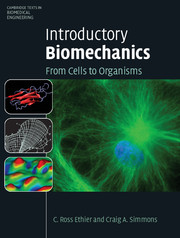Book contents
- Frontmatter
- Contents
- About the cover
- Preface
- 1 Introduction
- 2 Cellular biomechanics
- 3 Hemodynamics
- 4 The circulatory system
- 5 The interstitium
- 6 Ocular biomechanics
- 7 The respiratory system
- 8 Muscles and movement
- 9 Skeletal biomechanics
- 10 Terrestrial locomotion
- Appendix: The electrocardiogram
- Index
- Plate section
- References
1 - Introduction
Published online by Cambridge University Press: 05 June 2012
- Frontmatter
- Contents
- About the cover
- Preface
- 1 Introduction
- 2 Cellular biomechanics
- 3 Hemodynamics
- 4 The circulatory system
- 5 The interstitium
- 6 Ocular biomechanics
- 7 The respiratory system
- 8 Muscles and movement
- 9 Skeletal biomechanics
- 10 Terrestrial locomotion
- Appendix: The electrocardiogram
- Index
- Plate section
- References
Summary
Biomechanics is a branch of the field of bioengineering, which we define as the application of engineering principles to biological systems. Most bioengineering is applied to humans, and in this book the primary emphasis will be on Homo sapiens. The bioengineer seeks to understand basic physiological processes, to improve human health via applied problem solving, or both. This is a difficult task, since the workings of the body are formidably complex. Despite this difficulty, the bioengineer's contribution can be substantial, and the rewards for success far outweigh the difficulties of the task.
Biomechanics is the study of how physical forces interact with living systems. If you are not familiar with biomechanics, this might strike you as a somewhat esoteric topic, and you may even ask yourself the question: Why does biomechanics matter? It turns out that biomechanics is far from esoteric and plays an important role in diverse areas of growth, development, tissue remodeling and homeostasis. Further, biomechanics plays a central role in the pathogenesis of some diseases, and in the treatment of these diseases. Let us give a few specific examples:
How do your bones “know” how big and strong to be so that they can support your weight and deal with the loads imposed on them? Evidence shows that the growth of bone is driven by mechanical stimuli [1]. More specifically, mechanical stresses and strains induce bone cells (osteoblasts and osteoclasts) to add or remove bone just where it is needed. Because of the obvious mechanical function played by bone, it makes good sense to use mechanical stress as the feedback signal for bone growth and remodeling. But biomechanics also plays a “hidden” regulatory role in other growth processes, as the next example will show.
[…]
- Type
- Chapter
- Information
- Introductory BiomechanicsFrom Cells to Organisms, pp. 1 - 17Publisher: Cambridge University PressPrint publication year: 2007



